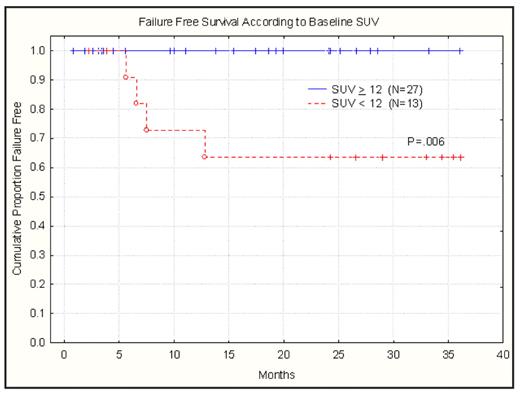Abstract
The FDG-PET/CT scan has become a standard tool in management of NHL. Failure to achieve an early metabolic CR (mCR) has been previously associated with a poor outcome and is considered as an adverse prognostic feature. Most studies which have supported this finding have used standard CHOP+/−R therapy or included a small or histologically heterogeneous population. As more effective therapies are introduced, some proven prognostic factors will lose relevance. We designed a prospective study to answer the following questions: 1- is the PET scan still capable of predicting outcome with the newer dose dense CHOP−R? 2) Is a very early PET, one week after the first chemotherapy (W1 PET) as good or better as the traditional 3rd course PET scan (C3 PET)? We have entered 55 pts, of which 40 were frontline previously untreated histologically aggressive NHL (35 DLCL, 5 FLCL) and 15 previously treated recurrent NHL (9 DLCL, 3 transformed DLCL, 2 PTCL, 1 high grade NOS). Treatment consisted of CHOP-R in all pts (dose dense in 38/40). A baseline PET was performed and followed by a W1 PET and a C3 PET. Median follow up is 20 mos. IPI was ≥2 in 20/55 (37%). The failure free survival (FFS) at 24 months was 85% for previously untreated pts and 35% for previously treated. For previously untreated pts, median baseline SUVmax= 20.5 (5.6–66.6) and one week after the first course (W1 PET), median SUVmax dropped to 2.6 and by C3 PET the median was 0. We examined the correlation between baseline PET, W1 PET and C3 PET with clinical outcome in previously untreated pts and found that the best correlation was with the baseline PET (figure).
Table 1 shows that the W1 PET as well as the C3 PET failed to correlate with outcome in previously untreated pts. Those who achieved mCR (defined as SUV<4) on the W1 PET or C3 PET didn’t have a significantly superior FFS than those who didn’t reach mCR. Other cut-off points including SUV<3 and <2 gave similar results. IPI, although showing a trend for correlation with FFS in previously untreated pts, was not significantly associated with outcome: IPI <3 had FFS= 87% vs. ≥3 = 82%, P=0.62. For the 15 cases with recurrent aggressive NHL, the FFS was 100% for those whose W1 PET SUV<4 versus 13% for those with SUV≥4 (P=.013). For those with baseline SUV ≥12 it was 52% vs 0% for SUV <12. For previously treated pts with IPI <3 the 2 yr FFS= 50% vs 0% for those with IPI≥3.
Conclusions- for previously untreated pts: a- Striking improvements in PET are seen as early as 1 week after chemotherapy and improved further by C3 PET, but their correlation with the clinical outcome was poor and only the baseline PET SUV correlated well with outcome. b-Those with an SUV below the typical range for DLCL (i.e. <12) were the only ones who relapsed. c- IPI was not significantly associated with outcome. For previously treated pts both the baseline and the W1 PET were predictive of outcome. IPI also correlated with outcome. A possible explanation for these unexpected findings in the frontline group is that traditional prognostic factors might have changed with the introduction of the more effective dose dense CHOP-R regimen. Our FFS of 85% is better than expected for the traditional 21 day CHOP-R. This erosion of traditional prognostic factors might also be reflected by the lack of correlation between the traditional IPI and clinical outcome. For previously treated pts where the impact of treatment is not as prominent, the post treatment PET and IPI still hold as prognostic factors. These findings might not necessarily apply to other histologies or to other treatments.
Table 1:
| W1PET SUVmax . | N . | %FFS 24 mos. . | P value . |
|---|---|---|---|
| <4.0 | 24 | 83% | |
| ≥4.0 | 16 | 90% | 0.68 |
| C3PET SUV max | |||
| <4.0 | 35 | 83% | |
| ≥4.0 | 3 | 100% | 0.59 |
| W1PET SUVmax . | N . | %FFS 24 mos. . | P value . |
|---|---|---|---|
| <4.0 | 24 | 83% | |
| ≥4.0 | 16 | 90% | 0.68 |
| C3PET SUV max | |||
| <4.0 | 35 | 83% | |
| ≥4.0 | 3 | 100% | 0.59 |
Disclosures: No relevant conflicts of interest to declare.
Author notes
Corresponding author


This feature is available to Subscribers Only
Sign In or Create an Account Close Modal